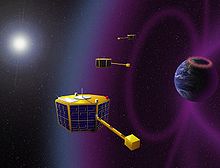New Millennium Program
The New Millennium Program ( NMP , German New Millennium Program ) is a development program launched by NASA in 1995 , which aims to test new space technologies for the new millennium. The missions within this program primarily serve to test technology and only secondarily to gain scientific knowledge. The New Millienium Program is organized by the Jet Propulsion Laboratory .
Originally, the missions were divided into the groupings Deep Space (DS) for interplanetary missions and Earth orbiting (EO) for missions in Earth orbit. After a reorganization of the program, all further missions were called Space Technology (ST).
Missions
The following missions are included in the New Millennium Program:
Started:
- Deep Space 1 - a space probe for testing an ion drive - launched on October 24, 1998 with a Delta II rocket - mission successfully completed.
- Deep Space 2 - two penetrator probes for Mars exploration - launch on January 3rd, 1998 with a Delta II rocket together with the Mars probe Mars Polar Lander - mission failed.
- EO-1 (Earth Observing-1) - a satellite for testing a new earth observation sensor, the Advanced Land Imager (ALI) - launched on November 21, 2000 with a Delta II rocket.
- ST-6ASE - Experiment for the autonomous fulfillment of tasks by satellites - Software experiment which was carried out with the EO-1 satellite.
- Space Technology 5 (NCT - Nanosat Constellation Trailblazer) - Test of the formation flight of three small satellites - Successful launch with a Pegasus XL rocket on March 22, 2006.
- ST-6ISC - Experimental star sensor in TacSat-2 - launched on December 16, 2006 with a Minotaur-1 rocket.
- ST-7 -Testing technologies for the Laser Interferometer Space Antenna (LISA) mission, discontinued in 2011 due to budget constraints. ESA, on the other hand, financed the successful LISA Pathfinder mission , the start was planned for 2014 and was postponed to December 3, 2015. There is a plan for an ESA-funded mission in 2034 under the name eLISA / NGO to use the technology.
Posted:
- EO-2 (SPARCLE) - laser instrument for atmospheric research - discontinued in 1998 for budget reasons.
- ST-3 (formerly DS-3) - double satellite for testing interferometric star observation techniques - reduced to laboratory experiments for budget reasons.
- ST-4 (Champollion, formerly DS-4) - mission to study comets - discontinued in 1999 for budget reasons.
- EO-3 (GIFTS) - geostationary instrument for weather observation - has been discontinued.
- ST-8 - Testing of various technologies (computer systems, construction structures for solar cells, expandable mast elements for sun sails, etc., heat control system) - Start on a Pegasus-XL was planned for February 28, 2009. In the meantime discontinued.
See also
Other NASA programs:
- Discovery program
- New Frontiers Program
- Earth Observing System
- Mars Scout Program
- Centennial Challenges Program
Web links
Commons : New Millennium Program - collection of pictures, videos and audio files
- NMP site of NASA (English)
Individual evidence
- ↑ NASA: Earth Observing-1
- ↑ EO 1 in the NSSDCA Master Catalog , accessed on July 28, 2013 (English).



